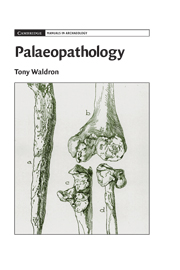Book contents
- Frontmatter
- Contents
- List of Figures
- Preface
- 1 Introduction and Diagnosis
- 2 Bone Metabolism and Pathology
- 3 Diseases of Joints, Part 1
- 4 Diseases of Joints, Part 2
- 5 Bone forming and DISH
- 6 Infectious Diseases
- 7 Metabolic Diseases
- 8 Trauma
- 9 Tumours
- 10 Disorders of Growth and Development
- 11 Soft Tissue Diseases
- 12 Dental Disease
- 13 An Introduction to Epidemiology
- Select Bibliography
- Index
- References
1 - Introduction and Diagnosis
Published online by Cambridge University Press: 05 June 2012
- Frontmatter
- Contents
- List of Figures
- Preface
- 1 Introduction and Diagnosis
- 2 Bone Metabolism and Pathology
- 3 Diseases of Joints, Part 1
- 4 Diseases of Joints, Part 2
- 5 Bone forming and DISH
- 6 Infectious Diseases
- 7 Metabolic Diseases
- 8 Trauma
- 9 Tumours
- 10 Disorders of Growth and Development
- 11 Soft Tissue Diseases
- 12 Dental Disease
- 13 An Introduction to Epidemiology
- Select Bibliography
- Index
- References
Summary
The study of disease in earlier societies stands firmly in the purview of the discipline of the history of medicine. There are a number of ways in which the subject can be approached, such as from the study of extant medical texts or of pictorial or plastic art and artefacts. However, the most direct approach is from the examination of the physical remains of our ancestors. Each approach has its limitations and calls for different skills. The preservation of documentary evidence is subject to random vagaries, at least as great as the preservation of human remains. The medical historians must be able to set their interpretation of the written word in the context of the various theories of disease extant at the time the original was written. Medical historians will also almost certainly need to be proficient in some languages other than their own. Those who attempt to diagnose disease from paintings, pots or sculpture will need to be familiar with the artistic conventions of the artists whose artefacts they study.
Palaeopathologists have the advantage of being able to study directly the remains of the diseased, although usually only in part, and this ability may be the only factor in their favour. The principal disadvantage that constrains palaeopathologists is that their study is restricted largely to those diseases that affect the skeleton – preserved soft tissues being decidedly unusual in most parts of the world.
- Type
- Chapter
- Information
- Palaeopathology , pp. 1 - 11Publisher: Cambridge University PressPrint publication year: 2008



